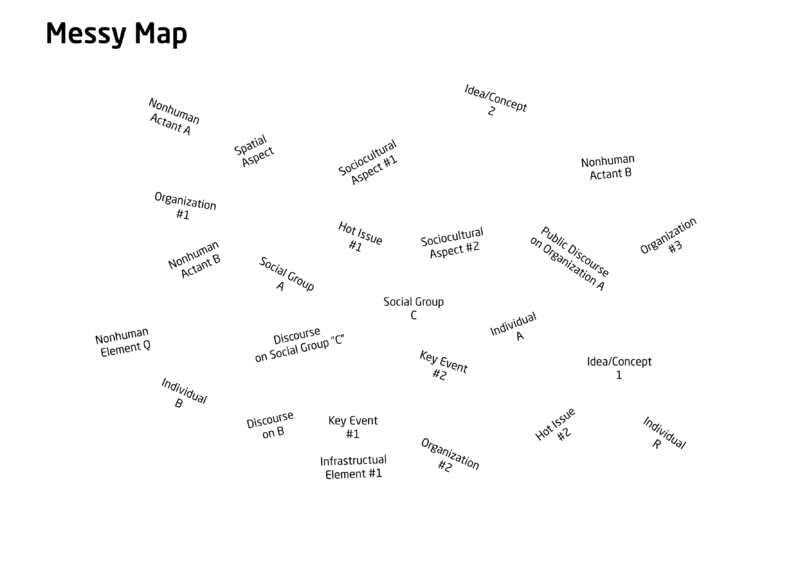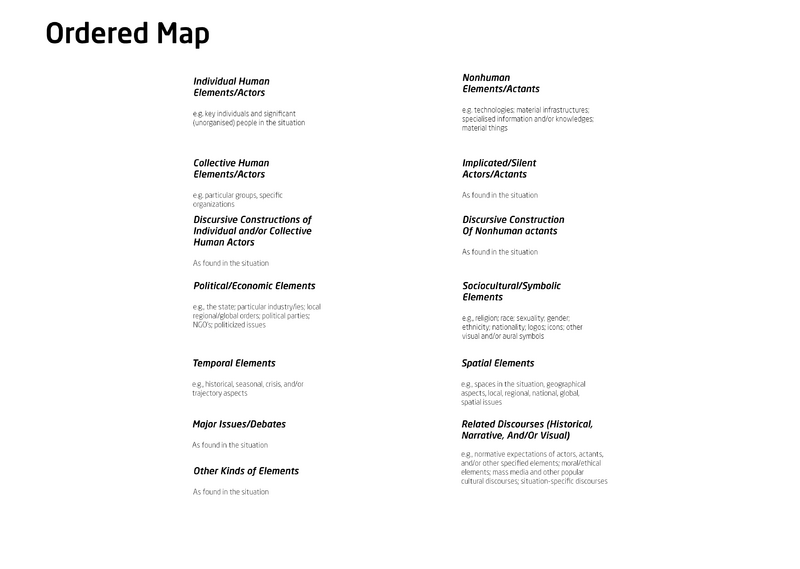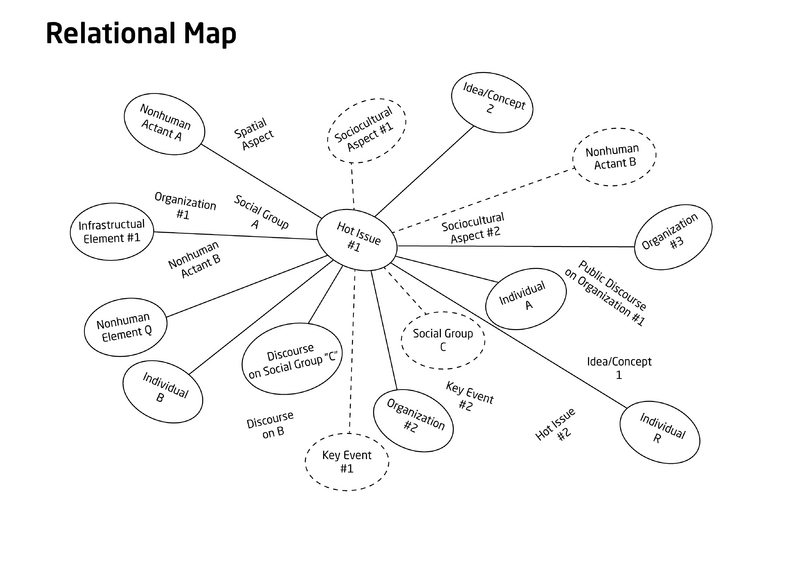Situational mapping
| Line 1: | Line 1: | ||
== Abstract == | == Abstract == | ||
| − | Whenever a '''project or program''' is conducted it is oftentimes with the intention of changing the status quo of the current situation. It is therefore not so irrelevant to know what the situation is and what impact the offered change in the status quo will have on the situation. Any given situation consists (for the most parts) of the same elements; '''human and non-human''', material and symbolic/discursive elements. The "human" element is everything human related and can in relation to PPPM best be described as "stakeholders". Knowing stakeholders and their relation to the situation is important but understand all elements of the situation is even more important. By knowing the other elements of the situation a project/program manager can mitigate even more risks and uncertainties that are dwelling in the complexity of their activities. | + | Whenever a '''project or program''' is conducted it is oftentimes with the intention of changing the status quo of the current situation. It is therefore not so irrelevant to know what the situation is and what impact the offered change (a so-called translation) in the status quo will have on the situation. Any given situation consists (for the most parts) of the same elements; '''human and non-human''', material and symbolic/discursive elements ''as framed by those in it and the analyst'' ref> Adele E. Clark (2005).Doing Situational Maps and Analysis. Chapter in "Situational Analysis: Grounded Theory after the Postmodern Turn", Thousands Oak Sage: page 83-144 </ref>. The "human" element is everything human related and can in relation to PPPM best be described as "stakeholders". Knowing stakeholders and their relation to the situation is important but to understand all elements of the situation is even more important. By knowing the other elements of the situation a project/program manager can mitigate even more risks and uncertainties that are dwelling in the complexity of their activities. |
| − | '''Situational mapping''' is an analytical tool and a prerequisite to another situational analysis tool '''Development Arena'''[http://wiki.doing-projects.org/index.php/Development_Arena_in_Project_Management], when used can give a better understanding of the situation the project or program is trying to change. Situational mapping consists of three different maps; '''Messy map''', '''Ordered map''' and '''Relation map'''. The maps are worked with in a chronological order with the last being the relational map. As one goes through the steps of analyising the situation with the three maps the important aspects becomes clearer and subsequently the different actors "human" or "non human" each with their unique relationship to eachother | + | '''Situational mapping''' is an analytical tool and a prerequisite to another situational analysis tool '''Development Arena'''[http://wiki.doing-projects.org/index.php/Development_Arena_in_Project_Management], when used can give a better understanding of the situation the project or program is trying to change. Situational mapping consists of three different maps; '''Messy map''', '''Ordered map''' and '''Relation map'''. The maps are worked can be worked with in a chronological order with the last being the relational map or all three maps can be worked with simultaniously, if the time frame allows for greater abstraction. As one goes through the steps of analyising the situation with the three maps the important aspects becomes clearer and subsequently the different actors "human" or "non human" each with their unique relationship to eachother or maybe the same "common concern", "commitment to action" or "shared objects" will form based on these three into "Actor Worlds"and then eventually they will start to populate the Development Arena. |
| − | Situational mapping can be seen as advanced stakeholder analysis where not only the stakeholders are populating the arena but literally everything else that can have | + | Situational mapping can be seen as an advanced stakeholder analysis where not only the stakeholders are populating the arena but literally everything else that can have a sizeable impact on the project or program is mapped and accounted for. |
== Introduction == | == Introduction == | ||
| Line 12: | Line 12: | ||
=== Situatinal Mapping Part 1: Messy Map === | === Situatinal Mapping Part 1: Messy Map === | ||
| − | - The messy map is the first part of the situational mapping tool. | + | - The messy map is the first part of the situational mapping tool. |
- With the messy map every conceivable thing can be put down in a "messy" kind of fasion | - With the messy map every conceivable thing can be put down in a "messy" kind of fasion | ||
| Line 25: | Line 25: | ||
* What are the spatial elements; geographical aspects, local, regional, national, global etc. | * What are the spatial elements; geographical aspects, local, regional, national, global etc. | ||
| − | - The messy map can be iterated upon until it feels saturated. From one iteration to another, | + | - The messy map can be iterated upon until it feels saturated. From one map-iteration to another, different elements can become obsolete and others can become more important. |
[[File:SM messy map.png|800px|thumb|center|''Figure 1: Messy Map]] | [[File:SM messy map.png|800px|thumb|center|''Figure 1: Messy Map]] | ||
=== Situatinal Mapping Part 2: Ordered Map=== | === Situatinal Mapping Part 2: Ordered Map=== | ||
| + | |||
| + | |||
[[File:SM Ordered Map.png|800px|thumb|center|''Figure 2: Ordered Map]] | [[File:SM Ordered Map.png|800px|thumb|center|''Figure 2: Ordered Map]] | ||
Revision as of 09:50, 22 April 2023
Contents |
Abstract
Whenever a project or program is conducted it is oftentimes with the intention of changing the status quo of the current situation. It is therefore not so irrelevant to know what the situation is and what impact the offered change (a so-called translation) in the status quo will have on the situation. Any given situation consists (for the most parts) of the same elements; human and non-human, material and symbolic/discursive elements as framed by those in it and the analyst ref> Adele E. Clark (2005).Doing Situational Maps and Analysis. Chapter in "Situational Analysis: Grounded Theory after the Postmodern Turn", Thousands Oak Sage: page 83-144 </ref>. The "human" element is everything human related and can in relation to PPPM best be described as "stakeholders". Knowing stakeholders and their relation to the situation is important but to understand all elements of the situation is even more important. By knowing the other elements of the situation a project/program manager can mitigate even more risks and uncertainties that are dwelling in the complexity of their activities.
Situational mapping is an analytical tool and a prerequisite to another situational analysis tool Development Arena[1], when used can give a better understanding of the situation the project or program is trying to change. Situational mapping consists of three different maps; Messy map, Ordered map and Relation map. The maps are worked can be worked with in a chronological order with the last being the relational map or all three maps can be worked with simultaniously, if the time frame allows for greater abstraction. As one goes through the steps of analyising the situation with the three maps the important aspects becomes clearer and subsequently the different actors "human" or "non human" each with their unique relationship to eachother or maybe the same "common concern", "commitment to action" or "shared objects" will form based on these three into "Actor Worlds"and then eventually they will start to populate the Development Arena.
Situational mapping can be seen as an advanced stakeholder analysis where not only the stakeholders are populating the arena but literally everything else that can have a sizeable impact on the project or program is mapped and accounted for.
Introduction
Situational mapping - a prerequisite for the Development Arena
Situatinal Mapping Part 1: Messy Map
- The messy map is the first part of the situational mapping tool.
- With the messy map every conceivable thing can be put down in a "messy" kind of fasion
- The messy map seeks to cover in detail what the given situation entails.
- Who are the main human actors; - individually, social groups, organisations etc.
- What are the nonhuman actors; Technology, Weather, infrastructure, material things
- What are the discourses; sdscourses within social groups, organisations, or even society
- What are the major issues; related to the situation
- What are the sociocultural or symbolic elements; religion, race, gender, sexuality etc.
- What are the spatial elements; geographical aspects, local, regional, national, global etc.
- The messy map can be iterated upon until it feels saturated. From one map-iteration to another, different elements can become obsolete and others can become more important.
Situatinal Mapping Part 2: Ordered Map
Situatinal Mapping Part 3: Relation Map
Situatinal Mapping Part 4: Actor Worlds - "bridging situational mapping and development arenas"
Situational mapping as a PPPM tool
Application
Limitations
Annotated bibliography
- Clark, A. (2005). Doing Situational Maps and Analysis - Situational Analysis: Grounded Theory after the Postmodern Turn
- Clark, A. & Star, S. (2008).The social worlds framework: a theory-methods package . - The New Handbook of Science and Technology Studies
- Jørgensen, U. & Sørensen, O. (2002) Arenas of Development - A Space populated by Actor-Worlds, Artefacts and Surprises



